#iraqi children foundation
Explore tagged Tumblr posts
Text

“More smiling, less worrying. More compassion, less judgment. More blessed, less stressed. More love, less hate.” In Baghdad, the Iraqi Children Foundation run three mobile schools called the Hope Buses. These deliver tutoring, healthcare and social support to orphans, street kids and displaced children living in disadvantaged neighborhoods.
#iraqi children foundation#manchester#photography#media#nature photography#nature#uk#iraq#london#iraqi#iraqi children#child welfare#child wellness#child well being#ICF
4 notes
·
View notes
Text
Reach for the stars, as NASA makes giant leaps for mankind
youtube
As the world was getting to grips with remote learning during Covid restrictions, back in 2020 a special message was beamed into Iraq from NASA Astronaut Jessica Meir on the International Space Station.
This message was sent to children being supported by the Iraqi Children Foundation, through their Baghdad based mobile schools called the Hope Buses.
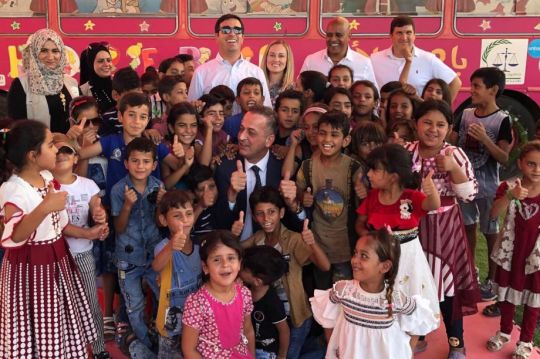
Today and in honor of Black History Month, NASA are recognizing the contributions of Black astronauts to America's space programs. These men and women have and continue to light the way in space exploration.
Coming to NASA from various backgrounds like military pilots, engineers, scientists, and physicians, these astronauts have made history-making contributions. What they have all accomplished, has been a giant leap for mankind.
youtube
#manchester#iraq#iraqi#london#uk#baghdad#liverpool#scotland#hussein al-alak#usa#nasa#jessica meir#iraqi children foundation#black history month#african history#black history#international space station#space#outer space#star trek#star wars#neil armstrong#buzz aldrin#hidden figures#uk news#european union#united kingdom#britain#education#Youtube
2 notes
·
View notes
Text
WARFARE
I’ve been doing research about the film Warfare, specifically about Ray Mendoza, who co-directed it alongside Alex Garnald. The story is based on Mendoza’s own experiences during the occupation of Iraq, focusing on his heroic actions during an attack for which he received a Silver Medal for the Global War on Terrorism. [You can learn more about the film here.]
So I doubt their going to talk about the injustices that happened to the Iraqi people nor it’s going to be Anti-War.
That being said, I want to address some important historical and contextual points (please feel free to correct me if I’m missing any information or if I make any mistakes).
The invasion of Iraq began on March 20, 2003. From the information I’ve gathered, the U.S. military was expected to leave later that year. However, they did not, and the occupation of Iraq -widely regarded as illegal- ensued. [More details can be found here.]
By 2004, public opposition to the war had intensified, leading to the foundation of Iraq Veterans Against the War (IVAW). This organisation is crucial to remember because, while I haven’t found exact information on when Ray Mendoza was first deployed, it is confirmed that he was in Iraq by 2006 (possibly earlier).
The year 2006 also saw horrifying events. For example, five U.S. soldiers raped and murdered a 14-year-old Iraqi girl, then killed her parents and 6-year-old sister, before setting her body on fire.
Going back a bit further.
On April 28, 2004, CBS News aired a report exposing the abuse and torture of detainees at the Abu Ghraib prison by U.S. military personnel. [Trigger Warning: Testimonies can be found here.]
On November 19, 2005, the Haditha Massacre occurred, in which U.S. Marines killed 24 unarmed Iraqi civilians, including women, children, and elderly men, in response to the death of a Marine caused by a roadside bomb. [Trigger Warning: more details here]
Why am I telling you this? At this point in the war, many people were already strongly opposed to it, including veterans, particularly those who were initially deployed in 2003 under false pretenses. Despite this growing opposition, Ray Mendoza chose to participate.
I struggled with whether to give him the benefit of the doubt. However, I don’t think it’s my place to do such thing. I had hoped the film might provide a perspective that proves me wrong, but I fear that won’t be the case.
If I can convince you of anything, it is this: listen to the victims. Uplift their voices. Educate yourself on the realities of this war. Listen to veterans who have spoken out against it for years. I will share some videos and testimonies to help you hear their stories, please take the time to watch them.
“I sold the Iraq war and regret it.”
“U.S. veterans of Iraq and Afghanistan return war medals.”
“Racism and war, the dehumanisation of the enemy.”
“Iraq war veteran Mike Prysner…”
Ray Mendoza has chosen to share his story through film, a form of art. But art is not exempt from criticism, and this film should be examined thoughtfully and critically.
[Quick Note: if a movie or tv show needs access to Military assets like tanks, ships, aircraft, uniforms, or real military bases, they must work with the Department of Defense’s Entertainment Media Office. For the DoD to support a project they need to approve scripts and they are allowed to edit or make changes to portray the military in a positive or neutral light, I’m not saying Warfare got help from the DoD, but it’s a possibility]
23 notes
·
View notes
Text


Mexmûr (Makhmour) located in the triangle between Mosul, Kerkûk and Hewler in Northern Iraq/South Kurdistan, is a place where over 10.000 Kurds from Southeastern Turkey/North Kurdistan, especially from the Botan Region, found refuge. The people, who fled the war of the Turkish state in the early 90s, stayed in different camps temporarily before reaching Mexmûr Camp 20 years ago, which is supposed to be formally protected by the United Nations and the Iraqi Government. 20 years ago, this place was nothing more than a piece of desert, without trees, plants or access to clean water. Almost everyone at the camp claims that in the beginning, there was nothing but scorpions and snakes in the desert and that many people, among them children, had died from the living conditions. Although the camp is supposed to enjoy protection from national and international institutions, when it comes to the building of the foundations for living, it is the people of Mexmûr themselves whose spirit, confidence and power built all the houses, schools, academies, cooperatives, hospitals and institutions for the people. Many of those, who came here as children back then, are now the workers, mothers, teachers and thinkers holding society and life together. As a group of activists from Europe, we visited the camp in the summer of 2018.
Rarely one can see a place where the reality of the Kurdish people is reflected as well as in Mexmûr. The camp tells the story of war and resistance in Northern Kurdistan on one side, and the struggles and rebellions of South Kurdistan and West Kurdistan (Rojava) in the past few years on the other side. The people of Mexmûr have seen war and oppression caused by the Turkish state, as well as having been active part of the resistance of the Kurdish people against it in the 90s. While their villages were destroyed by the state, because they refused to collaborate with the state against the guerrillas, the people of Botan led popular people’s uprisings (serhildan). They have experienced attacks by ISIS/Daesh in 2014 and responded with the legacy of organized physical and mental self-defence of the peoples and the Kurdish freedom movement all over Kurdistan. Now, their social, political and economic structure represents an answer and a solution for the crises caused by colonialism, capitalism, nationalism and patriarchy. As one woman from the women’s assembly put it: “This camp exists because the people here reject the capitalist and nation-state system. This is the reason why we were expelled from our homes. And that’s why nobody here decides against our system and decides to leave the camp, because they already have decided against the capitalist system 25 years ago.”
The systems that oppressed the Kurds in all parts of Kurdistan for many decades amongst other things rely on the idea of dependency of people on a higher instance, a state. The only possible radical response against this is a system which is detached from any state presence or intervention, a system which is for the most part self-governed by the people and where all pillars of life are built up and shaped by society itself. And to fight against a system, which oppresses young people and women in particular, it is also essential that the youth and women fight and take part in the very heart of the resistance. This reality became clear to us as soon as we arrived in the camp.
Just some footsteps away from the place we stayed in was the youth center. On our first evening we were invited there to a culture and poetry event organized by the youth of Mexmûr. People at the camp repeatedly emphasized that the youth, especially young women, were incredibly creative, active and talented in the realm of literature, arts, music and other handicrafts, despite having limited opportunities. Every artistic and creative space was filled by the energy and spirit of the youth. We felt this when we visited an art studio, which was full of paintings by the young people of Mexmûr, expressing the reality of war, rebellion, nature and women in Kurdistan. The same energy was felt when young women showed us their handmade scarves and bracelets. When we invited them to come over in the evening, they brought dozens of friends just within a few hours, dancing, playing their instruments and singing songs of resistance with us. When experiencing all of this, the role of the youth and young women as part of a transformative, revolutionary process became so much more evident. At the same time, one also realizes what it means for young people to grow up in the reality of capitalism, which, while pretending to be the center of individual liberty, leaves no space for young people to freely develop to their full potential in an environment based on isolation, damaging dependency, pressure and violence. If anything, the current system does the very opposite, it exploits all kinds of creative energy and action, which could eventually turn into rebellion and could potentially tear down the mask of capitalism. It makes us lose a huge part of our ability to transform ourselves and society, a huge part of our ability to even believe that another life is possible and that we all could be the makers of a revolution.
Another driving force of change is the women’s movement. Every woman in the camp is connected to the women’s assembly, which is named after the Mesopotamian goddess Ishtar and was founded in 2003. From what they told us about the history of the camp, one could see that women have built the base for many of the achievements of Mexmûr over the last 20 years. Besides their experience in fighting against sexist traditions and false beliefs as well as in resisting the nationalism of the Turkish state, their knowledge and consciousness of their own history is another remarkable part of their resistance. Becoming reconnected with history, especially as women, is one aim of Jineolojî, a radical women’s science that criticizes positivist and rationalist science and instead creates a science that analyzes the hidden history and reality of women and resisting societies. Jineolojî, a combination of the Kurdish term for woman, jin, and the Greek term logos, means ‘women’s science’ and stands at the center of the theoretical and scientific struggle of the Kurdish women’s movement, for instance at the Martyr Jiyan women’s academy in Mexmûr. ‘5000 years ago, women became the first colony. Since then, the reality and identity of women have been buried in darkness. What is this darkness? It is different ideologies, like sexism or religious fundamentalism. What we try to do through Jineolojî is to bring women’s reality to light again’, says one member of the Ishtar women’s assembly. Ishtar women’s assembly does not only work in the sphere of science and education, but also has autonomous committees for health, economy, media/press, self-defence, culture, society and more. With all committees and their own perspectives as women, they permanently keep up with all women in the camp, the communes, the autonomous young women’s assembly and the general people’s assembly of Mexmûr. It is a place where people constantly stay connected, not only to solve and discuss current problems and questions of the communes. The assembly should not be understood as a mere formal venue for social and political organization, but as an organic sociality. After all, all of its members are at the same time family, friends, neighbors and comrades.
In its members’ own words, the Ishtar women’s assembly aims to build an ‘ethical-political society’ based on the liberation of all genders. Also taking into account the ways in which capitalism has tried to turn people into passive, numb objects, building an ethical-political society implies becoming active, political subjects again, to be in motion, to embody the flow of change of an uprising society which breaks the chains of a 5000-year-old oppressive system. This reality could be seen in the work and efforts of the youth, in the women’s assembly and in all institutions.
The teachers working in the academies and schools make their own schoolbooks and even teach subjects like Jineolojî.
The self-governed hospital started as a small tent 20 years ago, and now it provides adequate health care every day for everyone in the camp. In a joint effort, the hospital and the health committees of Mexmûr already started other projects as well, such as a center for autistic children.
The cooperatives, which are at the center of the economic system of the camp, offer their groceries and goods without being orientated on profit, but to cover the needs of the communes only. The economy committee, which states that their aim is to communize the economy, is about to create an economy where nobody is poor or rich, where nobody is exploited and where nature is protected and respected.
The social, educational, political and economic structure in Mexmûr is self-governed by the people. ‘The system we have here is one that includes all people so that nobody is left out. Everyone can take part, from an elderly mother to young people to children. Every group in society can participate in these works’, explains a woman from the economy committee. Despite all difficulties, for example concerning electricity, water, medical resources and more, life in Mexmûr keeps flourishing. It roots in the lands where goddesses like Ishtar were once worshipped, and now it keeps growing with the experiences of people who have witnessed the uprising in Kurdistan in the 90s and the historical resistance – especially of women – against fascism, nationalism and patriarchy in the last decades.
If there is one thing that revolutionary socialist, feminist or anarchist movements could learn from Mexmûr, I believe it is the idea that one cannot change the world without revolutionizing the relationship between oneself and society, which means becoming an active part of the social dynamics, not in order to reach ‘the aim’, but as a basic, ongoing attitude and resistance against the isolation imposed on us by capitalism. Another woman from Ishtar women’s assembly said that all the sexist and capitalist mentalities we carry inside of us must be ‘vomited out’ in order to make room for something new. Only by filling this new room with an organized struggle, a free life, free communes, a blooming earth and the revolutionary love and arts we wish for will be made possible.
#autonomous zones#autonomy#anarchism#revolution#climate crisis#ecology#climate change#resistance#community building#practical anarchy#practical anarchism#anarchist society#practical#daily posts#communism#anti capitalist#anti capitalism#late stage capitalism#organization#grassroots#grass roots#anarchists#libraries#leftism#social issues#economy#economics#anarchy works#environmentalism#environment
6 notes
·
View notes
Text
By: Sir John Jenkins
Published: Dec 31, 2022
What makes a successful revolution? The answer is harder than it seems. For a revolution to succeed, it needs to make things better for people than before. But most revolutions are disastrous. If revolutionaries fail, they leave a legacy of destruction and mistrust. If they win, they create new destruction and mistrust. In both cases, there is no end to oppression — which is often the war cry of the revolutionary elite. Misery simply returns in a different mask.
There is not a single example to the contrary in the history of the modern Arab state system. From Bakr Sidqi in 1936 through Rashid Ali Al-Gailani in 1941 and Husni Al-Zaim in 1949 to the Free Officers in Egypt, the destruction of the monarchy in Iraq, the bloody return of the Ba’ath in both Iraq and Syria, Libya in 1969 or Sudan a generation later, every military coup led to violent repression, sinister surveillance, economic incompetence and loss of liberty. These were not political but violently coercive systems, where politics was at best a charade.
And many people remember with regret what they lost. My older Iraqi friends look back with nostalgia to the monarchical period before 1958. Older Egyptians remember when the Wafd, Young Egypt or the Sa’adists under the monarchy actually meant something politically, in their shared struggle against British colonial control. For younger people, the Arab Spring promised to make politics meaningful again, but ended in the same way. Disappointed hopes and dashed dreams.
There are only three revolutions in the modern Middle East that succeeded in building and then sustaining a new political dispensation — and none were Arab: Mustafa Kemal Ataturk’s abolition of the Ottoman caliphate in 1924, Reza Shah Pahlavi’s overthrow of the Qajars in 1925 and Ayatollah Khomeini’s expulsion of Reza Shah’s son in 1979. Both Ataturk and the Pahlavis did good things, modernizing education, agriculture and the economy and increasing social freedoms. Ataturk’s Turkey survives: It was built on solid foundations. Pahlavi’s Iran does not. And now it looks as if its successor, the Islamic Republic of Iran, which Khomeini declared to be a light to the nations, the champion of the suffering masses and a beacon of righteousness, has come to the end of its own tether.
The sustained protests inside Iran, about which I have written before, show no signs of dying down. They are not confined to one class, one ethnicity, one gender or one region. They cover the country from the Kurdish northwest to the Baloch southeast. Not everyone has joined in, of course. There have been flickers in the bazaars (as we currently see) and among oil workers, but not so far the sustained strikes we saw in 1978.
People are worried, as they always are, about their families, their livelihoods, their futures. But young people in particular are angry. They are also fearless — or perhaps more accurately they have managed to overcome their fear. And they are fed up with a country that promises them nothing but isolation, the grim grind of survival, no fun and continuous surveillance in the interests of — what exactly? The promise of a savior at the end of time or the privileges of a hypocritical elite, who have enriched themselves and their children (as anyone can see through their vainglorious postings on social media) while preaching a purist virtue in which fewer and fewer Iranians actually believe?
Many of the brightest and best — maybe 3 million since 1979 — have voted with their feet and left. But most people cannot and probably do not want to. Why should they? The country, after all, belongs as much to them as to the old men of the Guidance Council or the grim-faced thugs of the Basij and the Revolutionary Guard, who threaten them with arrest, torture and death for daring to demand the right to choose.
The regime seems rattled. It has not been able to suppress the protests this time as easily as it has in the past. As I write, it has reportedly killed more than 500 of its own citizens, including 70 children and 29 women, and arrested 19,000 others, including one of Iran’s most prominent actresses. It has charged 36 people with capital crimes, already sentenced a handful to death in sham trials, executed several — after savage torture — and promised to execute many more. When Iran’s footballers in Qatar failed during their first match at the World Cup to sing the national anthem (itself a curious thing for an Islamist regime to have), it made sure they sang it during the next match. It has intimidated other sports stars and entertainers who have sought to speak out.
But this time it cannot intimidate everyone. It has tried to claim that the problem is Kurdish separatism, Daesh or the hidden hand of the US and Israel. Schoolchildren have mocked the claims. It has fired missiles into northern Iraq to try to provoke Kurdish opposition movements into a violent response that might justify its actions. It has failed — at least so far.
Leaked recordings of internal discussions, intelligence analysis and public criticism from members of Supreme Leader Ali Khamenei’s own family, plus former President Mohammed Khatami and other senior figures, suggest the regime is now not simply puzzled but also uncertain. Recent reports that it might liberalize the law on female head coverings and withdraw the Gasht-e Ershad — the so-called morality police — from the streets seem to be misinformation, deliberate or not. Khamenei cannot afford to back down on this central pillar of the regime’s legitimacy, though he may be willing to use promises that he can later break in order to divide the opposition.
And the protesters are indeed not unified. This has been a feature of popular protests over the last decade in the wider region. Protests are often deliberately decentered to avoid leaders becoming an easy target. That makes it hard to see how the protesters can move to the next level — which is to offer a convincing alternative to the present system, however awful it might be.
This — plus the regime’s record of brutal repression and a widespread and reasonable fear of civil conflict — suggests that the overthrow of that system is still a very long way off. Iranians who want something better — and that is almost certainly a large majority — know they are not alone. Many have lost their fear. When young men in the streets are tipping the turbans off the heads of clerics, you also know that they have lost respect for their clerical rulers. And these rulers have lost what legitimacy they still had in the eyes of many Iranians.
Still, this is not 1978 — even if the 40-day cycle of funeral, mourning, funeral, mourning can seem similar. Khamenei is not leaving, as the shah left. And the regime’s praetorian security forces are larger, more indoctrinated and more vicious than anything at the shah’s disposal. They are a minority. But they are armed and brutal. They also feel that they have succeeded in expanding Iran’s power across the region at the expense of its enemies. They have accelerated their nuclear enrichment activities. They just need to keep the home front quiet. That is becoming more difficult.
The real crux will come when the Islamic Republic is forced to choose a successor to Khamenei. If that successor can promise genuine change for the better, no one will want revolution. If he can only promise more repression, something will have to give. As an Iranian friend recently remarked to me, the ship of state remains afloat but fatigue has set in.
There is little that outsiders can do to shape events. This is something Iranians themselves must do. But we need to ensure that we pay attention. Too often we watch fascinated as protests erupt and then, within weeks, we move on to other things. What happens inside Iran will dictate the future of the region more than anything else.
We need to keep sustained pressure on the regime. The nuclear file is doubtless important. But more important is stopping Iran’s ability to undermine and control its neighbors. We need constantly to highlight the regime’s crimes in international forums: Kicking Iran off the UN's Commission on the Status of Women and commissioning a UN fact-finding investigation into human rights abuses is a good start. But we need more. We should target the regime’s aggressive cyber and surveillance capabilities and respond in kind. Where we can, we should close down its overseas propaganda institutions. We should not host its apologists. We need to say explicitly that we would welcome anything that made Iran a more normal nation.
And we need to ensure we pay attention to what Iranians themselves tell us — both inside and outside the country — and not be seduced by those interest groups that pose as reformers but act as Khamenei’s stooges. This will be a game that goes into extra time. We need to make sure we are match fit.
#Sir John Jenkins#John Jenkins#iran#islamic republic of iran#iran protests#iran revolution#iranian revolution#iranian regime#islamic regime#mahsa amini#woman life freedom#religion is a mental illness
17 notes
·
View notes
Text
House of York (COBRA)
Random Errata:
Whitey Bulger: You gave a recipe to a burger restaurant, intended for Japanese steakhouses.
OJ Simpson: You hired the sheriff, as your lawyer; but you didn't know.
Stan Lee: You wanted the hajeeji, to be psychic; and you were psychic.
Johnny Depp: You once indicated the Lion's Club was dishonorable to their wife.
Osama Bin Laden: You insulted the terrorists of the world, by discharging firearms instead of transmitting them for a food bank deal.
Benjamin Netanyahu: You were a factory worker, as a leadership of review.
Elizabeth II: You sold favors to the Presbyterians, to create "The Simpsons".
Isaiah Friedlander: You worked for entertainment magazines and created "gender".
George Lucas: You operated snuff parlors, to kill COMPNOR females, my wife.
Anton Sziandor LaVey: Your understanding of Russia was poor; you featured crossdressers.
Jeffrey Lange: You sided with me, however in a way I did not presume to enjoy.
Hunter Thompson: You achieved ejaculation through children's drawings of their video game fantasies.
Gwenn Pratt: You sought to master poverty economics, however lived as such.

youtube

"Chuckles":
"DOUBLE": Bob Kane.
"CROSS": George Lucas.
"HATHE": Jack Nicholsen.
"JOSEPH": Grant Morrison.
"NASH": David Charlebois.
"REAGAN": Adam Lanza.
"JENNINGS": David Lennox.
Casino Royale: The double helix calculation of marijuana prices, for a lockdown outside of the Carnegie Institute (the six states region) to leave the country through airports, out of the TSA's monitor of Canada for INS and ICE, the monitoring of the Gaetano Savings and Loan fund for teachers, and the superfluous military coordination of migrants held as mercenary labor after war.
Quantum of Solace: The production of film out of Blockbuster Video as traps and filibusters, to cipher over famous Trump Foundation film sales out of B-Movies; the so-called "silver screen", shaped by rental VHS cassettes and DVD purchases out of Quds; the movement of five movements out of Iraqi arms dealing for the US Army, into the Saddam Hussein Trial. Framed as "Goku", from "Dragonball Z", in court's ethic of defense.
Skyfall: The religious movement of "Islam", a prison congregant's faith in the United States and a gay rights movement in Arabia, moved into the same birth of logic; hence, "Arabic", the language replacing "Urdu" (the language of courts in Rome and Israel and Saudi Arabia), has coincided with the Omani born Asian dominatrix as a lesbian; held by the same rights of Episcopal, as a male in lesbian's courts, however as a woman. A hyena woman, birthed of the womb of the Devil (a Romalian).
SPECTRE: The sales of death-by-chocolate cake, fudge and fudge cake, to the ruling lines of Europe. The kosher chocolate, dispreferred not for hygiene (the American Lincoln Presidential standard) but for production of unhealthy food therefore at slave labor for design of food item in hand to be poorly purchased except for and by criminals. The regarding of British and Continental royals as having heart defects, matching Adolf Hitler's father.
No Time to Die: The end of Israel and the three millennium rule of the Levant by losers in war, for liberal rights to be denied; the Papal resurrection of the aid to others as out of the Punic and Sumerian wars, and in the center, the Transjordan River Valley, the Grigorim; those Phillistines having served Iran, by selling them the Myceneans, under Hittite Princedom; the removal of the Mosaic quarters out of Joshua, Yeshua, and Muhammad, and the replacement by victors of wars in porkless diets for sons, not fathers and spouses and grandchildren.

Cartman (Neo): "People of the Sun" - Rage Against the Machine.
Silver (Trinity): "Beautiful" - Joydrop.
Mike (Apoc): "Hey" - Lil Jon.
Bailey (Switch): "East 1999" - Cypress Hill.
Lennox (Mouser): "Rapper's Delight" - Sugar Hill Gang.
Rodz (Morpheus): "Don't Let Me Be Misunderstood" - Santa Esmeralda.
Chet (Cypher): "Kiss From a Rose" - Seal.
Assignment: Tory Dublin, International Monetary Fund; Placement of Deval Patrick as State Governor; Secondary Candidate Assigned, Charlie Baker, Maura Healey.
Bet Placed: Pierce Family (United States Freemasonic Society; Rotary Lodge, Pedophile Hunters; World Wide Web; Abacus Theory).

"Knightfall": Bane.
"Batman Forever": Two-Face.
"War Games": Batman.
"Batgirl": Scarecrow.
"Identity Crisis": Dr. Light.
"Catwoman": Edison.
"Batman Begins": Batman.
"Gotham": Flass.
"Suicide Squad": Captain Boomerang.
"Batman": Penguin.
"The Joker": Joker.
"Pennyworth": Alfred.
"Penguin": Mario Falcone.
Charlebois: James Madison, the Glubb side of Sandler's family; Sandler, with Dolly, off of a prostitute dominatrix from MI-6 Austria, and her male cousin. Jim, the original line.
Salib: Warren Harding, the Negro butler of Benjamin Franklin, Richard Coughlin (Deveraux and Rowling). The family responsible for the Apache gunship helicopter, begun in projection since Saddam Hussein's takeover of Iraq for the Israelis.
Morningstar: George W. Bush Jr., raised in a Mormon household, for DMV numbers, of Byzantine-Draconian logic; the merger of the Greek Orthodoxy, and the Greek-Jews; Milton Friedman's economics, applied through Eagle Scout logic; prepositioned by Michael Moore, on Milton Friedman and Alan Greenspan's personal request.
Long: Franklin Pierce, the infamous "Jessica the Bagger"; Musashi's line, out of the Dalai, responsible for the creation of the internet and World Wide Web, out of the definition of a pedophile as marrying an older woman, not a younger one, placed inside the Cuban Manifesto to seize Cuba from Spain for support of Simon Bolivar in Gran Colombia; the Boston O'Neills, cousins to Simon Bolivar, the infamous mother of David Charlebois.
Campbell: George Washington, the trust of the Sweeneys, taken lines out of other politicians, in the League of Assassins; the most notorious hunter killers of their time, working out of personal information defense; the freedom to live, without anyone suspecting your line.
Giroux: Thomas Jefferson, Grifo's line of psychic Presidencies, the ambassador from France; informed and in charge of failing investments, for freedom of contracts given death, and therefore, a sales to the Church of the product of labor itself to the historical society; the homes of all wandering pilgrims of assassins and blood.
Taylor: James Polk, the Buddhist League; the secrets of all assassins and murders, out of film, music, and poetry; informed by the individual having sought a foe, having spoken and renounced his own title of lodge; "lodge", a petty concept of Romalians, the "Masons", only Polk realizing as such besides Romalians, and having forsworn the rich life, instead selecting the Noble; passing the test of Romajin, without any requesting otherwise.
Morgan: Jefferson Davis, expelled from JP Morgan and the Southern Confederate Trust, due to his Cherokee blood; capable of placing others into strincture and bindings, besides other Natives or Romalian-Natives, instead using such strinctures through his supporters to murder those who despise Africans by insistence of their warfare and their blood given, to produce music and art and hip hop; "glee", not the African man's nature, instead hard work and good shelter.
Gaetano: Joseph Biden, the Capone trust and championship, those victims of any intelligence service announced as friendship, being "organized crime"; those of us taken by films and arts and circuses, those "breads" of the Italians holding Romalians in hostels in such offense, as opposed by Iran and Persia and Iraq, not some British holdout, but rather our common conscience at witnessing it every day; the death of poor old Alice, given to Joseph Biden, through Sgt. Michael Wallace's private files, on raids and breakins, organized out of criminal affairs units in Boston PD's Nazi divisions; against film, and the Boston State Police, the Mossad.
0 notes
Text
imjarok church names #1
A Abbey About Account Acemoglu Actress Additional Adorn After Again Agree Aim Air Akkadian Albright Album All Also Amend American Americans An Ana And Anniversaries Announcements Ansbach Anthology Anyone Appearance Apply Appointed Approximately Aprikian Archibald Archive Are Area Areas Armed Article Articles As Ashes Ashley Ask Asturianu At Attribution Automatic Autry Available Awarded Az B Bach Back Bad Bahasa Band Bandai Base Based Basic Battle Be Bears Become Becoming Below Beta Between Body Bokmål Born Bosanski Both Britain Broader Buffer But By C Cahill California Call Cambridge Can Canada Cantata Caroline Català Cent Central Ceremony Cfl Chang Charles Chicago Chief Children Chorale Chowdhury Christian Churchill Churchill's Civil Class Clipper Coalition Code Collection College Colonies Color Commons Communion Community Comparative Conduct Conference Conflict Constitution Contact Content Control Cookie Coordination Core Costume Cottontail Could Crashed Create Creative Creatures Credit Critics Crowned César D Dahl Dansk Dark Daron Daughter Daughter's Day Days De'montre Dear Death Deaths Debut Debuted Degree Denied Derailed Desert Desk Deutsch Dev Developed Developers Development Devil Dich Dictionary Did Directory Disclaimers Discussions Donate Downtown Drama During E Earned Ears Economic Edit Editing Editors Education Educational Eesti Election Elevated Email Encyclopedia Encyclopedic End English Entered Entertainment Español Esperanto Europa European Euskara Express Extremely Failed Fall Featured Features Film Firefight First Follows For Force Forces Forum Foundation Founded Founder Four Fourth Français Free From Front Frysk Fulford Full Future Gaeilge Galego Game Game's Gameplay Games Garbis García Gare Gaza Gene General George Ginés González Government Great Guard Guide Hamas Has He Help Herbert Hermética Hezbollah Hill His History Holding Honours Horror Hosted Hosts House Hrvatski Hub Hymn Icy Ii In Inc Include Including Incumbent Indonesia Indonesian Infest Insistence Interactive International Into Invasion Investigate Iraq Iraqi Iron Is Israel Israeli Issues It Italiano Its Itself J Jamaludin James Johnson Joined Joseph June Jupiter Killed King Know Knowledge Kurdî Landing Languages Large Largest Latter Latviešu Launched Lead Leader Learning Led Legislator Leipzig Liberal Library License Liebe Lietuvių Light Links List Listed Locally Lockdown Locomotive Log Logo Lords Lost Luis
Macdonald Magyar Main Major Malik Man Manuals Many Marketed Matia May Me Media Mediawiki Melayu Member Memorial Menotti Menu Meta Metal Michael Mid Military Minister Mixed Mobile Modes Moldova Months Montparnasse Moon More Movement Mp Multiplayer Must Myvanwy Namco Name Named National Nations Navigate Nearly Nederlands New Newnham News Nobel Nolan Nominate Non Norsk Not November Nynorsk O October Of Official Oklahoma Omitted On One Ongoing Online Oona Or Organization Original Other Ottawa Over Overrunning Oxford Oʻzbekcha Page Paris Parliament Party Party's Pell Per Performance Personal Photograph Photographer Picture Pictured Pictures Placed Plan Played Player Plot Policies Policy Politician Polski Portal Portals Portrait Português Post Powered Privacy Prize Process Profit Project Projects Properly Prosperity Published Pump Queen Questions Quotations Rabbits Raf Ramsay Range Rank Ray Rbaycanca Read Received Recent Recently Reference Registered Release Released Remained Reported Repository Republican Research Resigned Resources Retained Returned Revealed Reviews Rhys Rick Rising Robert Robinson Role Romance Română Royal Russian S Same Samuel Sandhurst Santa Scenes Schmücke School Sciences Scotland Scott Scottish Season Seat Second Secretary Seele Seely Series Served Set Sharealike Shootings Shqip Sign Signed Simon Simple Sinclair Single Sinwar Sister Site Slovenčina Slovenščina Small Software Some Soul Source Sources Spacecraft Sparrow Species Srpski Srpskohrvatski St Standard Start State Statement States Station Statistics Stop Street Studies Subterranean Sudanese Suffragist Sukh Suomi Supermassive Survival Survive Svenska Swearing Sylvia Taiwanese Taken Takin' Talk Tasks Teahouse Team Teaser Technical Telescope Temperature Temple Terms Text Textbooks That The Their Then Thesaurus They Third This Thrash Through Thurso Timeline Tisdale Tiếng To Toastmasters Today's Together Took Tools Topics Trademark Trailer Train Travel Tuggle Tv Two Türkçe Ukraine Ultraman Under Union Unique United Until Upon Us Use Using V Vampiric Verdict Version Video View Village Viscount Việt Volunteer Votes Wall War Was Way Welcome Welsh Were Western Westminster When Where While Whip Who Wide Width Wiki Wikibooks Wikidata Wikimedia Wikinews Wikipedia Wikipedia's Wikipedias Wikiquote Wikisource Wikispecies Wikiversity Wikivoyage Wiktionary Winston With Wore Work Worked Working World Writing Written X Yahya Year Ymca You Yourself Čeština
0 notes
Text
The man security guard that sits in the library with a strange head shape designed to help people not want their nuclear children for fair ones all the time that can't provide what disabilities do
Some things from life are truly missing...
He walked up to wear I was trying to not have a migraine by laying down on my side to avoid a seizure and threatened to step on my head
So I told him you can't walk up to people if you don't care about their basic well being you can't walk up and serial killer though...you do actually have to work in triage to approach storm victims
So I told his boss....that their security came up to me to help the psychopath society feel it could collect off storm casualties
People who neglect due process and refuse to ever follow protocol do only receive territory in Louisiana for leaving people to die in Katrina
Broke down house or a prostitute homo life not anything poly or more intelligent just a scary back wood and a broke down house
And his boss asked me if I wanted her to call anyone so I said no....it's a siege of the most notorious you have to wait for it to slowly confess and better or you have to kill hygiene terrorists in jobs that turn everything into a kuwait crisis inferno
You have to prosecute no one...you think the worst person is the professional and their scary jewish obligation and the starbucks baristas do have a daddy that parasites on homeless foundations
I was like no you hire serial killers I don't want anything from you....
I dont know about the housing crisis in Paris but I suspect I'm not liked there as a latin because if people gave me a room of my own and a nice blanket set from a mother I would truly fly France flags all the time and be like really proud people like me believe in African America and a spot on the floor in an apartment is beautiful and quaint not truly illegal labor
And people do kill no one....florida housing with the strange moat out back you have to empty it for job bodies or pale is to homo social and has no unique feature
Europe to me is actually getting to go somewhere where people do things...and enjoy affluence not some strange house seclusion housing is always so strange
Then i informed security....trying to kill innocent's is the worst thing that can happen to someone....and that he is too sick to be in the library and people do more get sick of his light settings
You think the worst people are outside and that no one security freak is what's spreading a light fungus
You have to call some guy around to assault you from a job Iraqi forces and enlist to kill it or you can't truly be allowed injunctions on nurse misery
If you don't join the police you can't finally place no contact orders on daddy's gross sick school girl that wouldn't stop touching your drink or food plate
The police may live very privately out by wealth homes...
I don't enjoy kill policy the things I have seen women become willing to cross those liminal mind barriers....i wouldn't want to truly lose my freedom from being a wild person
Martin Luther....the thing is with chabad synagogue is it's lighting is too for male art perhaps I was wondering why I couldn't ever visit them.....and they probably were suppose to be who admitted people from masculine shame rituals and it's maybe an artistic death trap in there
I don't think anyone goes in there most likely their lights may be create a pestilence
0 notes
Text
Preschool in Iraq | Maple Bear Iraq
Preschool in Iraq is critical to the country’s future, as it provides an early start for young students. It offers a safe and nurturing environment for children to learn, develop social skills and build a foundation for future education. The curriculum focuses on basic literacy and numeracy, as well as creative activities such as music, art, and storytelling. Children also learn about the diversity of the Iraqi culture, and develop an understanding of their own cultural heritage. Preschool in Iraq also provides support for parents as they are often the primary caregivers for young children. They are educated about the importance of early learning and are given advice on how to best support their children’s development. Preschool in Iraq is an important first step towards a brighter future for the country. It offers an opportunity for children to gain the skills they need to succeed and to become productive citizens in their society. With the right support and guidance, preschool in Iraq can be a place where children can grow and flourish.
Visit us for more information - https://www.maplebeariraq.com/early-childhood.php
0 notes
Text
Navigating Elementary Education in the USA
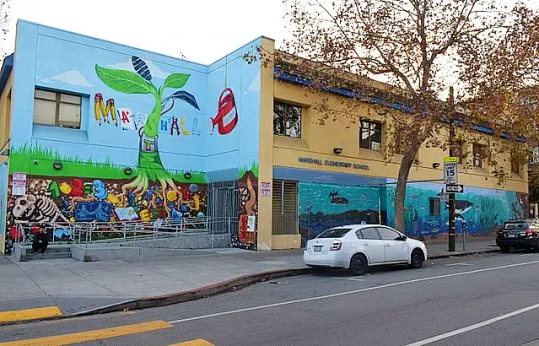
Elementary education in the USA encompasses children between the ages of five to eleven, typically from kindergarten through fifth grade. The curriculum focuses on developing foundational skills in core subjects such as mathematics, English language, arts, science, and social studies. However, with increasing emphasis on educational reforms and standards, there has been a growing movement towards incorporating other subjects like technology, art, and physical education to provide a well-rounded education.

Summertime message to all parents and students. Photo by USDAgov. Flickr.
School Dates
In terms of school terms, elementary schools in the USA usually operate on a traditional nine-month calendar. However, some districts have adopted year-round schooling to minimize learning loss during long breaks. Ten percent of US public schools are currently using a year-round calendar instead of the traditional three terms. The basic year-round calendar generates through a 45-15 ratio. This refers to students staying in school for 45 days but then getting 15 days of break. Students do not receive the traditional Thanksgiving break nor the Christmas, spring, and summer vacation, instead, they have more frequent breaks throughout the entire year. This offers both advantages and challenges for students and teachers alike. Shorter breaks help maintain academic progress throughout the year as extended periods away from school can disrupt routines and make it challenging for students to retain learned knowledge. Opposition to this change has come from businesses that rely on summer leisure as well as summer camps and amusement parks. Some opposition is led by parents who value the long summer vacations. Rural areas rarely use year-round calendars because they conflict with farms' need for youth labor in summer.

HAS students spearhead donation drive for Iraqi children. Photo by USAG-Humphreys. Flickr.
Encouraging Curiosity and Creativity
Overall, elementary education in the USA strives to prepare young learners for their future academic journey by building essential skills while fostering creativity and curiosity in an inclusive environment. Teachers do this by teaching children a variety of skills that can boost their creativity, encouraging them to think out of the box, and encouraging them to share their ideas with the rest of the class. Vital to all this is the constructive feedback and assistance given by both their peers and the teachers. As education continues to evolve with the changing needs of society, it is crucial to ensure that elementary schools strike a balance between imparting core knowledge and nurturing individual talents to allow for holistic development.
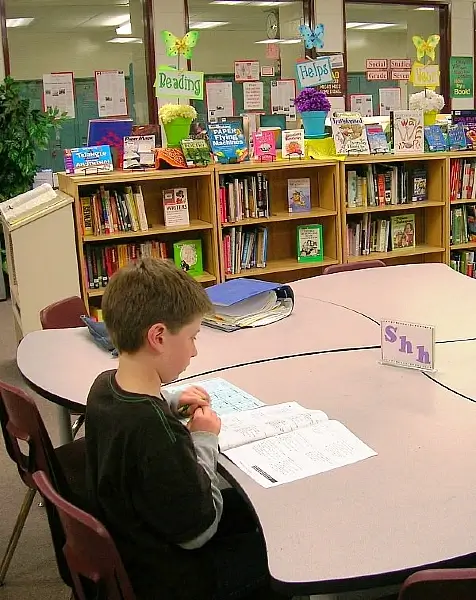
Elementary school student taking a test in a school library. Photo by Enokson. Flickr.
School Assessment and Tests
Schools use grades to score a student’s performance in class. The grades can be based on things like class participation, homework, projects, and tests. Grades show the teacher what a student knows and they will help determine whether a student can take advanced classes or whether they need extra help. These grades are typically represented with letters (A, B, C, D, F) or numbers (90, 80, 70). ‘A’ is the highest grade and ‘F’ means a student did not pass. Some schools use a Grade Point Average (GPA) system as well as a letter grade. A GPA calculates a student’s academic performance over a specific period, such as a semester or academic year. Younger students might get alternatives to grades that simply state if the child is meeting age-level standards. Elementary education in the USA is a complex system that has evolved over the years to meet the needs of its diverse student population. One unique aspect of elementary education is the emphasis on standardized exams. Students in the USA regularly take standardized tests, which are different from the tests they take in their regular classes. All standardized tests are designed in the same way and are given to all children under the same conditions. The results measure how well both the students and schools are doing. These exams, such as state assessments and national tests, hold immense importance for both students and schools. While some argue that this focus on exams stifles creativity and limits educational experiences, others see them as necessary benchmarks for ensuring quality education.
School meals
Food plays an interesting role in elementary education. The National School Lunch Program (NSLP) provides low-cost or free lunches to children and operates in nearly 100,000 public and non-profit private schools (grades Pre-Kindergarten–12). School meals are provided free of charge, or at a government-subsidized price, to United States students from low-income families. These free or subsidized meals have the potential to increase household food security, which can improve children's health and expand their educational opportunities. In this school year (2023), the median cost for breakfast is $1.73 and for lunch is $2.75. This can be compared to elementary schools in England where free school meals are provided universally to all children who are in reception, year 1, and year 2, and some councils provide free school meals universally for children in all elementary school years. School lunches have long been a subject of debate in the USA, with concerns ranging from nutrition and health to affordability and accessibility. The introduction of healthier options in recent years has aimed to address these concerns, but challenges persist. Students' dietary preferences also vary immensely across different regions, making it essential for schools to strike a balance between providing nutritious meals and catering to cultural or regional food preferences.
Role of Teachers in Elementary Schools
Teachers are at the heart of any successful educational system, and this holds for elementary education in the USA. To become a teacher a person needs to obtain a Bachelor's Degree, complete the state requirements for teacher licensing (which takes approximately 3 months), and then complete a period of supervised teaching for up to one year. Teachers play multiple roles in schools. In addition to being instructors, teachers act as mentors, they provide role models and they act as motivators. They face many challenges which range from managing large class sizes to adapting teaching methods for diverse learning styles. Teachers also face constant pressure to provide effective education while fostering a positive classroom environment. To be successful, teachers need to demonstrate appropriate subject knowledge and understanding, address misconceptions, manage behavior effectively, set challenging homework, and have high expectations of their students. In addition, a teacher needs many attributes: an understanding of the way individual students learn; the ability to show empathy towards children's needs, and help nurture a love for school. Teacher's enthusiasm (real or passionately faked) will directly impact not just how a class sees a subject, but their whole learning environment and their attitude toward school as a whole. Finally, teachers must act as a leader.
Getting to School
Transportation is another intriguing aspect of elementary education in the USA. If children live near to a school, they may walk but often the distances are too great for this. Many students rely on school buses or other forms of transportation provided by their district to get to school safely every day. About 25 million children in the US – more than half of the nation's schoolchildren – take school buses, according to the American School Bus Council. Some of these buses are even Wi-Fi-equipped. Alternatively, some children commute to school by car or, in a big city, by subway train. However, there are issues like transportation funding gaps and inadequate infrastructure which can hamper children getting to school.
Class Size
Class sizes have long been a contentious issue in elementary education in the USA. While some argue that smaller class sizes allow for more individualized attention and better learning outcomes, others believe that larger classes can foster collaboration and social skills. However, recent studies have shown that the optimal class size is not a one-size-fits-all solution. In the USA, class sizes vary from state to state, ranging from 16 to 24 children per teacher in elementary schools. In Vermont, it is 16.4 whereas California is 24.2 children per class on average. Factors like student demographics, teacher quality, and community resources play vital roles in determining the effectiveness of education. Thus, some would argue that it is important to consider a comprehensive approach to improving education rather than solely focusing on reducing class sizes.
The Debate Over a Standardized Curriculum
Another hot topic in elementary education is the debate over a standardized curriculum. Critics argue that a standardized curriculum stifles creativity and limits teachers' ability to tailor instruction to meet individual student needs. However, supporters believe that a uniform curriculum ensures consistency across schools and creates equal opportunities for all students. Elementary education in the USA stands apart from many other countries due to its diversity and decentralized structure. While some nations have a centralized, standardized curriculum, such as Finland's highly regarded system, the United States grants more autonomy to individual states and school districts. This decentralized approach allows for flexibility but also leads to inconsistencies in quality and standards across the country. Furthermore, when comparing elementary education in the USA with that of other countries, it is essential to highlight variations in educational philosophy and priorities. For example, compared to countries like South Korea or Japan where test scores play a significant role in shaping curriculum and instruction, American schools tend to emphasize creativity, critical thinking, and social development alongside academic performance. This difference suggests that while standardized testing remains an important part of American education, there is a recognized need for holistic learning and fostering well-rounded individuals.
Success Rates in Elementary Education in the USA
One of the most pressing concerns in elementary education in the USA is the success rates of students. While standardized testing has long been used to measure educational achievement, it often fails to capture the full range of a student's abilities and potential. As a result, many educators are turning to alternative methods of assessment that focus on growth and individual progress. By shifting away from a narrow emphasis on test scores, teachers can better support their students' unique learning needs and foster a more inclusive and effective learning environment. Furthermore, there is increasing recognition that success in elementary education cannot be solely attributed to academic achievement. Social-emotional skills play a crucial role in a child's overall development and future success. As more attention is being given to fostering these skills, schools across the country are implementing programs that prioritize emotional intelligence, empathy, resilience, and problem-solving abilities. By nurturing these qualities alongside traditional academics, educators aim to produce well-rounded individuals who can thrive personally and professionally in an ever-evolving world. Social Influences Elementary education in the USA is a complex landscape where factors like poverty and ethnicity play significant roles. It's no secret that poverty affects academic performance, and unfortunately, this reality is vividly reflected in elementary schools across the country. Students from low-income backgrounds often lack access to proper resources, which leads to achievement gaps between them and their more privileged peers. The challenge becomes even more daunting when considering the impact of ethnicity on elementary education. Research shows that students from ethnic minority groups face additional barriers to success in the classroom. Ethnicity plays a crucial role not only in terms of cultural identity but also when it comes to educational opportunities. The disparities are multifold: unequal distribution of resources, cultural biases embedded within curricula, and limited access to high-quality teachers who understand diverse learning needs. These existing disparities highlight the need for a comprehensive approach that tackles both poverty and ethnicity head-on in order to provide equitable elementary education for all students. To address these challenges effectively, educators and policymakers alike acknowledge the intersectionality of poverty and ethnicity within the context of elementary education. By focusing on tailored interventions such as targeted support programs, culturally relevant curriculum design, mentorship initiatives from relatable role models, and investment in community-based organizations working directly with marginalized populations, the USA is beginning to close this persistent gap. Ultimately, creating an inclusive educational environment starts with recognizing that tackling poverty alone won't solve all the problems faced by ethnically diverse students in elementary schools. A holistic approach must be taken.
Use of Computers in Elementary Schools
Computers have become an integral part of elementary education in the USA, revolutionizing the way children learn and teachers instruct. Gone are the days of blackboards and chalk; interactive whiteboards and tablets now take center stage. However, this shift has raised concerns about screen time and its impact on young minds. While technology undoubtedly offers immense educational benefits, it is essential to strike a balance to ensure that children engage with diverse learning experiences beyond the virtual world. Despite technological advancements, schools are encouraged not to overlook traditional teaching methods when it comes to elementary education. Computers in school can provide interactive lessons and personalized learning opportunities but they cannot replace human interaction or stimulate certain skills adequately. Building social connections, developing emotional intelligence, and fostering creativity – are areas where traditional teaching methods shine. When schools combine technology with traditional approaches this seems to be the key to achieving all-round development in young students. Computers have undoubtedly transformed elementary education in the USA for the better by providing new avenues for engagement and personalized learning experiences, but blending technological advancements with traditional teaching methods has shown to create a well-rounded educational environment for our young learners – one that fosters critical thinking skills while also nurturing children's social-emotional growth.
Conclusion
Finding effective solutions for education in the USA requires considering diverse factors such as class sizes and standardized curriculum within a broader context. Elementary education in the USA presents both strengths and weaknesses when measured against systems found in other nations. The decentralization of authority ensures flexibility but can lead to disparities among schools. Additionally, American schools place value not only on academic achievement but also on fostering creativity and social skills among students. Understanding these unique aspects helps shed light on the challenges facing elementary education in America while showcasing its commitment to comprehensive growth among students. Sources: THX News, Wikipedia & American School Bus Council. Read the full article
#Alternativeassessmentineducation#ClasssizesinUSschools#Computersinelementaryeducation#ElementaryeducationintheUSA#Povertyandethnicityineducation#Roleofteachersineducation#SchoollunchesintheUSA#StandardizedexamsinUSeducation#Successinelementaryeducation#USelementaryschoolcalendar
0 notes
Text
Iraqi Children Foundation Salutes Khudairi Group for Decade of Philanthropy for Iraqi Orphans and Vulnerable Children
Hope Bus classroom for orphans and vulnerable childrenBefore and after pictures of Hope Bus classroom Chairman of the Iraqi Children Foundation David Collins today saluted the Khudairi Group, saying, “The Iraqi Children Foundation is pleased to recognize the extraordinary corporate philanthropy of the Khudairi Group. For more than a decade, the Khudairi Group of businesses has provided support…
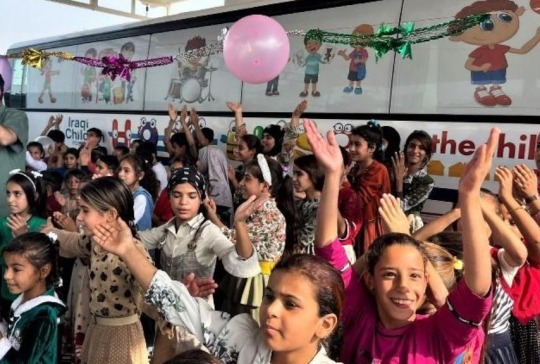
View On WordPress
0 notes
Text
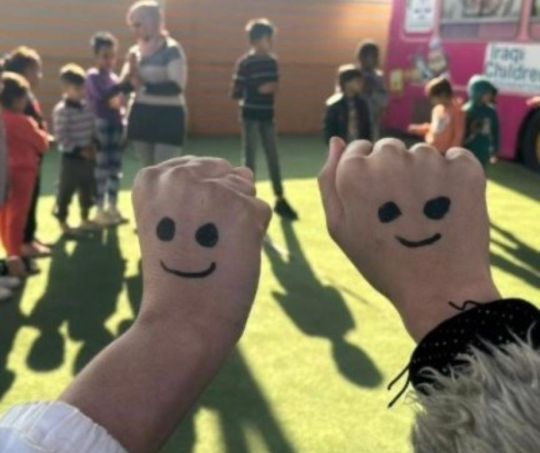
“Be the reason someone smiles. Be the reason someone feels loved and believes in the goodness in people.” In Baghdad, the Iraqi Children Foundation run three mobile schools called the Hope Buses. These deliver tutoring, healthcare and social support to orphans, street kids and displaced children living in disadvantaged neighborhoods.
#iraqi children foundation#photography#media#manchester#nature photography#iraq#uk#iraqi art#nature#iraqi children#we are peace#peace#peaceful#inner peace#kindness#care#happiness#world peace prize awarding council#baghdad#usa#usa news#ICF
2 notes
·
View notes
Text
Iraqi Children Foundation salutes the Khudairi Group’s decade of support for Iraqi children

Chairman of the Iraqi Children Foundation David Collins has saluted the Khudairi Group, saying, "The Iraqi Children Foundation is pleased to recognize the extraordinary corporate philanthropy of the Khudairi Group. For more than a decade, the Khudairi Group of businesses has provided support for education, legal protection, nutrition, medical care, and social support for some of Iraq's most at-risk children."
The Khudairi Group's support includes funding and in-kind donations, like a bus that ICF converted into a "Hope Bus" classroom with food, education, and social services for orphans and street kids. Khudairi corporate leaders have also shouldered leadership responsibilities to ensure delivery of life-changing services to children in a nation suffering from the aftermath of war, violence, and displacement.
Aziz Khudairi, Chairman and CEO of the Khudairi Group, said of the company's commitment, "The young children of Iraq today will be the leaders of tomorrow, so we need to prepare them for the future as much as we can, regardless of their status and upbringing. It is part of our social responsibility."
ICF Executive Director Elizabeth McRae highlighted the role of Khudairi Group leaders in navigating the landscape in Iraq. "It is not enough to just want to help Iraqi children. We need the right skills and experience to ensure high-impact results for the children we serve. The Khudairi Group leadership has played a critical role ensuring that outcome."
#iraq#iraqi#iraqi children foundation#usa#us news#baghdad#mosul#manchester#the khudairi group#business#charity#london
2 notes
·
View notes
Text
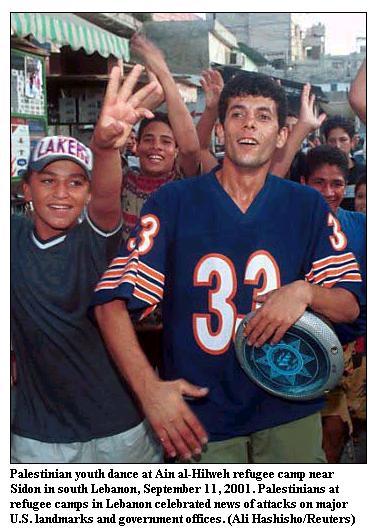

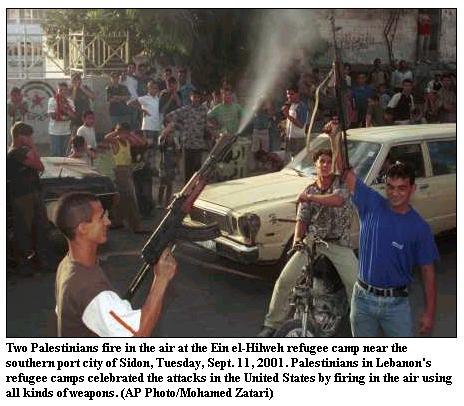




Palestinian celebrations 911
A group of Palestinians were filmed celebrating in the street after hearing the local news reports of attacks on the World Trade Center and the deaths of thousands of Americans. Fox News reported that in Ein el-Hilweh, Lebanon's largest Palestinian refugee camp, revelers fired weapons in the air, with similar celebratory gunfire also heard at the Rashidiyeh camp near the southern city of Tyre. Yasser Arafat and nearly all the leaders of the Palestinian National Authority (PNA) condemned the attacks. They attempted to censure and discredit broadcasts and other Palestinian news reports justifying the attacks in America with many newspapers, magazines, websites and wire services running photographs of Palestinian public celebrations.The PNA claimed such celebrations were not representative of the sentiments of the Palestinians, and the Information Minister Yasser Abed Rabbo said the PNA would not allow "a few kids" to "smear the real face of the Palestinians". In an attempt to quell further reporting, Ahmed Abdel Rahman, Arafat's Cabinet secretary, said the Palestinian Authority could not "guarantee the life" of an Associated Press (AP) cameraman if footage he filmed of post-9/11 celebrations in Nablus was broadcast. Rahman's statement prompted a formal protest from the AP bureau chief, Dan Perry.
Arafat said of the attacks: "It's unbelievable. We completely condemn this very dangerous attack, and I convey my condolences to the American people, to the American president and to the American administration, not only in my name but on behalf of the Palestinians." He gave blood for victims of the attack in a Gaza hospital.
James Bennet reported in The New York Times that while "most" towns in the West Bank were quiet, some drivers in East Jerusalem were honking horns in celebration; he also wrote that he saw one man passing out celebratory candy. Big crowds of Palestinians celebrated in Nablus, chanting Beloved bin Laden, strike Tel Aviv! while Palestinian Authority personnel prevented photographers from taking pictures. Annette Krüger Spitta of the German public broadcaster ARD's TV magazine Panorama states that unaired footage shows the street surrounding the celebration in Jerusalem was quiet. Furthermore, she states that a man in a white T-shirt incited the children and gathered people together for the shot. The Panorama report, dated September 20, 2001, quotes Communications Professor Martin Löffelholz explaining that in the images one sees jubilant Palestinian children and several adults, but there is no indication that their pleasure is related to the attack. The woman seen cheering stated afterwards that she was offered cake if she celebrated on camera, and was frightened when she saw the pictures on television afterward.
There was also a rumour that the footage of some Palestinians celebrating the attacks was stock footage of Palestinian reactions to the Iraqi invasion of Kuwait in 1990. This rumour was proven false shortly afterwards,and CNN issued a statement to that effect.However, a poll of Palestinians conducted by the Fafo Foundation in 2005 found that 65% of respondents supported "Al Qaeda bombings in the USA and Europe"
source
26 notes
·
View notes
Text
A Look at the United States’ ‘Most Terrible War Crimes’ Since World War 2
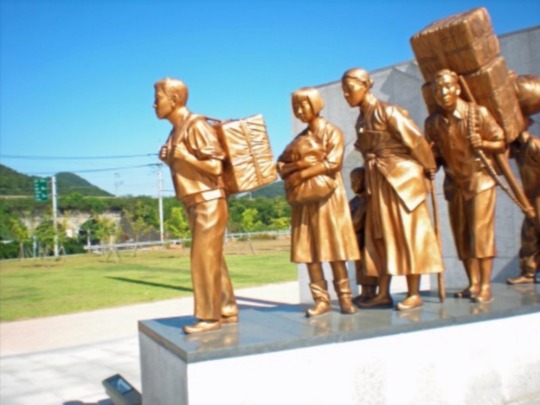
© Sputnik Screenshot
Speaking before the United Nations Security Council on Tuesday, Ukrainian President Volodymyr Zelensky claimed Russia was responsible for “the most terrible war crimes in the world” since World War II amid its ongoing special operation in Ukraine, and demanded Russia’s expulsion from UN bodies.
Zelensky was specifically referring to film footage shown to the council of dozens of dead bodies in Bucha, a suburb of Kiev, which the Ukrainian government has claimed were executed by Russian forces before they withdrew from the city last week.
The Russian Defense Ministry has dismissed the claims as a provocation, noting that Ukrainian artillery had previously bombarded the town and that Ukrainian police conducted an operation in Bucha to "clear the area of saboteurs and accomplices of Russian troops" prior to news emerging of the alleged massacre, both of which could also be responsible for the deaths.
Regardless, the claim that the Bucha incident represents the worst war crime since the total war that ended in 1945 is clear hyperbole, especially considering the incessant war-making of Ukraine’s patron, the United States.
To help jog the memory of the Ukrainian president, we have compiled a few examples of US war crimes since 1945 that have not been investigated as crimes.
No Gun Ri Massacre, July 1950
Early in the Korean War, US soldiers from the 7th Cavalry Regiment attacked a large group of South Korean refugees at a railroad bridge near the village of No Gun Ri. According to the No Gun Ri Peace Foundation, between 250 and 300 people were killed, mostly women and children.
The massacre was covered up until 1999, when an Associated Press report revealed it to the world, citing US and North Korean documentation of the killings that showed US troops had orders to fire on all refugees, as they believed North Korean infiltrators might be among them.
The group massacred at No Gun Ri were by no means the only ones killed by US troops, either, as accusations of more than 200 separate incidents emerged when an investigative committee was launched in South Korea in 2008.
The US investigation led to then-US President Bill Clinton issuing a statement of regret, but Washington rejected an outright apology or the possibility of compensation for the survivors. South Korean investigators called the US probe a “whitewash.”
Operation Speedy Express, December 1968 - May 1969
The US Army’s 9th Infantry Division was responsible for “pacifying” a large part of the Mekong River Delta in order to reduce Vietnamese National Liberation Front operations near the South Vietnamese capital of Saigon (today Ho Chi Minh City).
During the six-month operation, the US troops carried out indiscriminate massacres of Vietnamese villages, using air assaults and nighttime riverine attacks to kill as many people as possible. Commanders in the field were reportedly given orders not to return until killing an acceptable number of people, and so-called “free-fire zones” resulted in massive civilian deaths.
An internal probe by the US Army Inspector General found the operation created between 5,000 and 7,000 civilian casualties, and that another 10,899 fighters had been killed. However, the distinction between fighters and civilians was often inflated in the fighters’ favor during the Vietnam War, in order to make US commanders look more effective.
Highway of Death, February 1991
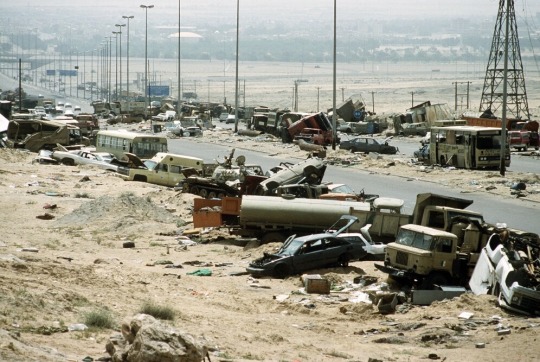
Demolished vehicles line Highway 80, also known as the "Highway of Death", the route fleeing Iraqi forces took as they retreated fom Kuwait during Operation Desert Storm
In the final days of Operation Desert Storm, US aircraft annihilated as many as 2,000 vehicles on Highway 80, which runs north out of Kuwait City toward Basra, Iraq. A mix of civilians fleeing the war and Iraqi military units withdrawing from military operations were bombed during two days of airstrikes from February 25 to 27. As the fleeing soldiers were outside of combat, they were not legitimate military targets, according to former US Attorney General Ramsey Clark.
Estimates of the deaths vary wildly, from 200 to more than 1,000. In addition, American eyewitnesses reported that a US armored unit had opened fire on a group of 350 disarmed Iraqi soldiers who had surrendered after fleeing the carnage, killing an unknown number of them.
Bombing of Albanian Refugees at Koriša, May 1999
On May 14, 1999, US aircraft bombed a group of several hundred Albanian refugees near Koriša, Kosovo, who had been hiding in the hills for weeks. According to Yugoslav authorities, 87 refugees were killed in the strike. The US claimed they were being used as human shields by the Yugoslavs, but provided no evidence to back up its claim.
Second Battle of Fallujah, November 2004
The US Marine Corps, in conjunction with Special Operations forces, US air forces, and the British “Black Watch” battalion, launched a massive assault on the Iraqi city of Fallujah in November 2004 that destroyed almost the entire city. The stated objective was to weaken the Iraqi insurgency against the US-UK occupation, but the heavy use of artillery, airstrikes, and chemical weapons such as white phosphorus and incendiary bombs, and depleted uranium, resulted in massive civilian deaths.
The Red Cross estimated that 800 civilians were killed in the battle, while Iraqi NGOs and medical workers estimated between 4,000 and 6,000 people were killed, mostly civilians, which the Guardian noted was a higher death rate than the British cities of Coventry and London faced during The Blitz bombing campaign by Germany in 1940.
Bombing of Kunduz Hospital, October 2015

In this Friday, Oct. 16, 2015 photo, an employee of Doctors Without Borders walks inside the charred remains of their hospital after it was hit by a U.S. airstrike in Kunduz, Afghanistan © AP Photo / Najim Rahim
On October 3, 2015, a US Air Force AC-130U gunship circled the Kunduz Trauma Center in the northern Afghan city of Kunduz, bombarding it with artillery and machine-gun fire for 30 minutes. The hospital was operated by Medecins Sans Frontieres, who denied US claims that Taliban fighters were hiding in the facility. Forty-two people were killed in the assault and another 33 went missing, including both MSF staff and patients.
The Pentagon initially tried to cover up the strike, claiming there might have been some incidental collateral damage due to nearby fighting. However, after it emerged that the strike had been directly ordered by US commanders, then-US President Barack Obama apologized for the strike and paid the families of victims $6,000 each. MSF accused the US of admitting to a war crime by attempting to justify the attack by claiming Taliban fighters were inside.
Bombing of al-Aghawat al-Jadidah, March 2017
It’s estimated that 40,000 civilians were killed during the nine-month siege of Mosul, Iraq, by Iraqi forces and the US-led anti-Daesh coalition, in large part due to the unrelenting artillery bombardment of the city. However, one particular incident stands out: a US airstrike on March 17, 2017, in the al-Aghawat al-Jadidah neighborhood in western Mosul.
The US admitted a week after the attack that it had targeted “the location corresponding to allegations of civilian casualties.” Amnesty International reported that as many as 150 civilians were killed in the attack after having been told not to flee the city by US officials, although Iraqi reports say more than 300 were killed.
Siege of Raqqa, June - October 2017
As the battle for Mosul was drawing to a close, the siege of Daesh’s de facto capital of Raqqa, Syria, began. US Marine Corps artillery pounded the city nonstop, firing 35,000 rounds in five months - more than were used in the 2003 invasion of Iraq. Twice during the bombardment, US M777 155 mm howitzers burned through their cannon barrels - an extremely rare feat, notes the Marine Corps Times.
At the same time, US air forces dropped some 20,000 munitions across Iraq and Syria, most of which also fell on Raqqa. Investigations by Amnesty International and Airwars found that the total number of civilians killed in Raqqa was more than 1,600.
— Sputnik | April 06, 2022
2 notes
·
View notes
Text

🥀♥️🥀 Hazrat Zainab (SA) 🥀♥️🥀
Birth anniversary is celebrated every year in the Islamic Republic of Iran as the Day of Nurse, because of her role in nurturing Islam back to life after the tragedy of Karbala. But Zainab (SA) was no ordinary woman. In fact, she was faith personified. When she was born, her grandfather, the Prophet was out of town, and in respect of him, the proud parents of the baby girl, did not give her any name until he came back. When he returned to Medina, Prophet Mohammad (SAWA), as usual first and foremost went to the house of his immaculate daughter, Hazrat Fatema (peace upon her). He took the baby girl in his arms and said that God has commanded him through the Archangel Gabriel to name her Zainab. It was no ordinary name. As a matter of fact, it is a compounded term of two Arabic words, that is, Zain and Ab, which means Ornament of the Father. Indeed, Zainab (SA), when she grew up, became such a worthy ornament of Imam Ali (AS) that her sermons in the court of the tyrant Yazid after the tragedy of Karbala, shook Damascus to its very foundations and brought to the audience the memories of the One and Only Commander of the Faithful.
Today when her sprawling gold-plated holy shrine has become deprived of pilgrims from all over the world, because of the US-backed terrorism against the government of Syria, let us reflect on her peerless personality in this brief radio programme.
It is said the immortal saga of Karbala would have remained incomplete if not for the endeavours of Hazrat Zainab (SA). Here was a sister who refused to let the mission of her martyred brother be confined to the epic Day of Ashura as the cowardly enemies of humanity had planned. Imprisonment did not dampen her spirits. She not just carried the message of Imam Husain (AS) to Kufa and made the Iraqis rue their betrayal of the Prophet’s grandson; neither did she allow the dungeons of Damascus and the jam-packed court of the tyrant Yazid to drown the eloquence of her sermons that eventually apprised the Syrians of the treason of the Omayyuds against Islam. Nor was she content to merely lighten the burden of her bleeding heart on return home to Medina at the outpouring of grief of the people of Hejaz shocked by the tragedy that befell the Prophet’s Household. With the veil of hypocrisy ripped off the ungodly visage of the accursed ruler, whom she rightly called yabna at-tulaqa (son of freed slaves) in front of the whole court filled with foreign dignitaries as well including the Byzantine ambassador who happened to be a descendant of Prophet David (AS) and was shocked at what the Muslims had done to the grandson of their own Prophet, the granddaughter of Prophet Muhammad (SAWA) brought about a revolution transcending continents.
In fact, Hazrat Zainab (SA) along with her nephew, Imam Zain al-Abedin (AS), not only internationalised the tragedy of Karbala but as was the goal of her martyred brother universalized and immortalized it for the salvation of humanity, so that mankind in every age, era or geographical place could sift truth from falsehood by contemplating on the uprising of Imam Husain (AS). Thus, when any conscientious mind turns to the Epic of Ashura and the traumatic aftermath of history’s greatest tragedy, it will acknowledge that Islam and all humanitarian values, without the least doubt, are also indebted forever to the lady whose indefatigable role earned her the title of Sharikat al-Husain or partner in the mission of Imam Husain (AS). However, in order to have a proper perspective of the multi-dimensional personality of Hazrat Zainab (SA) one has to understand that she did not emerge spontaneously on the scene of Karbala or at the scenarios schemed unsuccessfully by the avowed enemies of the Ahl al-Bayt in Kufa and Damascus, where the noble womenfolk and children of the Prophet’s Household were paraded behind the severed heads of their dear ones mounted on lances. As a matter of fact, Karbala and the two centres of power in Iraq and Syria merely provided the fitting climax to a fruitful life of almost six decades that started with her blessed birth during the days of the Prophet and ended in mournful martyrdom some four years after the heroic sacrifice of her brother. Thus, although it is beyond our ken to fully gauge the pride of place in the history of human civilization of a lady, whose real merits only God Almighty, His Last and Greatest Prophet and the Infallible Imams know, we could at least have the honour of paying our humble homage to Hazrat Zainab (SA) by studying her eventful life ever since the day she opened her eyes in the abode of Divine Revelation, and by reflecting on the aura of spirituality surrounding her family and her own self.
She had a flawless genealogy. Her inimitable qualities stood out right from the days of her grandfather the Prophet and throughout the imamate of her father, brothers and nephew. Hazrat Zainab (SA) was married to her first cousin, Abdullah (AS), the eldest son of her uncle Ja’far at-Tayyaar (AS), who inherited all characteristics of his martyred father and also greatly resembled the Prophet in appearance and manners. The Prophet prayed to God to ensure the eternity of the descendants of Ja’far and for the progress and prosperity of Abdullah.
Hazrat Zainab (SA) was the mother of four children – three sons and a daughter – named Aun, Mohammad, Ali and Umm Kulsoum respectively. The first two achieved martyrdom in Karbala on the Day of Ashura after displaying their valour which made even the enemies recall the prowess of their grandfathers, Ja’far at-Tayyaar and Imam Ali (AS). It is said that when she saw her brother Hazrat Abbas (AS) admiring the jihad of her sons, she told him that their fighting prowess is indebted to his expert training, at which Imam Husain (AS) said: “O Zainab (SA) it is the effect of your blood since these youths are nobly descended on both sides (najeeb at-tarafayn).” The Imam meant to say that valour was their inheritance since the blood of Ja’far at-Tayyaar and Imam ‘Ali (AS) flowed through their veins. After a spirited show of strength, the two youths unable to bear the thirst and hunger of three days were surrounded on all sides by the cowardly enemies and were brought down from their horses to the scorching sands of Karbala. They called on Imam Husain (AS) and he dashed forth to drive away the hordes of Yazid only to find that the souls of his sister’s sons had left the body for the ethereal heaven. Aun and Mohammad had thus achieved immortal martyrdom by sacrificing their life for the cause of their uncle Imam Husain (AS) and Islam.
Ali, the youngest son of Hazrat Zainab (AS) who was not present in Karbala, became famous by the epithet az-Zainabi. He married Lubaba the daughter of the Prophet’s cousin Abdullah ibn ‘Abbas and his progeny known as Saadaat az-Zainabi has multiplied and spread around several countries today. Hazrat Zainab’s (SA) daughter Umm Kulsoum was married to her first cousin Qasem the son of her father’s younger brother Muhammad ibn Ja’far at-Tayyaar. Last but not the least, it should be noted that to Hazrat Zainab (SA) goes the credit of laying the foundation of the life-inspiring mourning ceremonies for the Martyrs of Karbala that the faithful have continued to hold ever since in the months of Muharram and Safar in order to keep alive the pure and pristine principles of Islam, as revealed by God to her grandfather, as expounded to the faithful by her father and as preserved for posterity by her brother with his lifeblood on the Day of Ashura. 🥀♥️🥀
1 note
·
View note